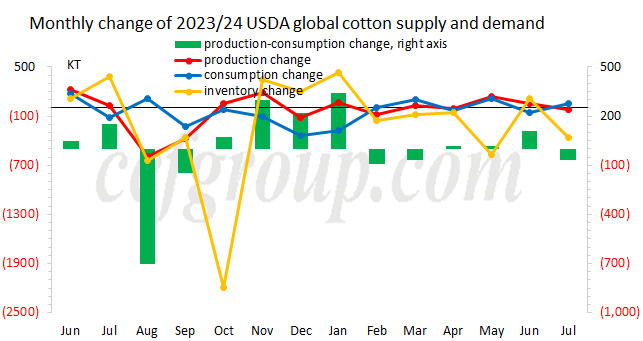Interpretation of USDA's July supply and demand report on cotton
1. USDA adjusts lower 2023/24 beginning and ending stocks in July
The US Department of Agriculture recently released the global cotton supply and demand report for July. This adjustment mainly focused on reducing the beginning and ending stocks for the 2023/24 crop year, while slightly increasing the consumption. Specific changes included a decrease of 260,000 tons in beginning stocks, a decrease of 360,000 tons in ending stocks, and a decrease of 50,000 tons in consumption. The stock adjustments primarily involved India, with an 110,000-ton decrease in beginning stocks and a 170,000-ton decrease in ending stocks, along with a consumption increase of 40,000 tons. Overall, as the 2023/24 crop year approaches its end, the beginning and ending stocks are expected to provide some support for US spot cotton prices. However, the impact on the ICE Dec cotton contract is not particularly significant. Currently, 2023/24 U.S. cotton export sales are basically in completion. Both the 2023/24 and 2024/25 U.S. cotton export sales remain subdued, and the pressure on US cotton trends persist.

2. USDA raises 2024/25 cotton production
Compared to the previous month's data, the main changes in the balance sheet for the 2024/25 crop year were once again an increase in production. The increase in production was mainly due to a 220,000-ton increase in the U.S., rising by about 6 percentage points. However, considering the earlier forecasted growth in planted area and current weather conditions, the production increase remained relatively conservative. Besides, Brazil has significantly increased its production twice since the beginning of this year, yet the USDA balance sheet has not been adjusted accordingly. Furthermore, a minor increase in cotton production in India in May has also not been reflected. Therefore, overall production adjustments still remain conservative, with potential for further increases later on, and the expectation of a generally ample supply has not undergone any substantive changes.
Overall, the USDA's adjustments to 2023/24 season are not significant, and 2024/25 cotton production is forecast higher further, albeit relatively conservative. This may be supported to the cotton market in the short term coupled with the drought in the main cotton-producing areas of the US, but factors such as the faster growing progress of US cotton, significantly faster harvesting progress in Brazil compared to the same period last year, remain objective realities. The mid-term downward trend in US cotton is likely difficult to stop. Additionally, the good-to-excellent ratio of US cotton has gradually fallen back to the level of the same period last year, but there are still many variables in terms of weather changes in the cotton-producing areas and their impact on the rate. In the Chinese market, the amount and timing of sliding-scale duty quotas allocation have always been a focus of the market. Despite marginal improvements in demand in Southeast Asia and China recently, the sustainability is still unclear. If quotas are allocated, it will undoubtedly lead to a "short-term prosperity" in imported cotton consumption.
- Top keywords
- Cotton Price
- Cotton Futures Price
- Cotton Futures
- CZCE
- PTA Futures Price
- Chemical Fiber
- Polyester Prices
- Wool price
- PTA Futures
- Shengze Silk
- China
- Yarn Price
- price
- China Textile City
- Fibre Price
- Benzene Price
- Cotton
- Index
- Cotton Index
- PTA
- fabric price
- NYMEX
- Top 10
- textile industry
- Spot Cotton
- Cotton Yarn
- Polyester Price
- Futures
- PTA Price
- cotton yarn price

